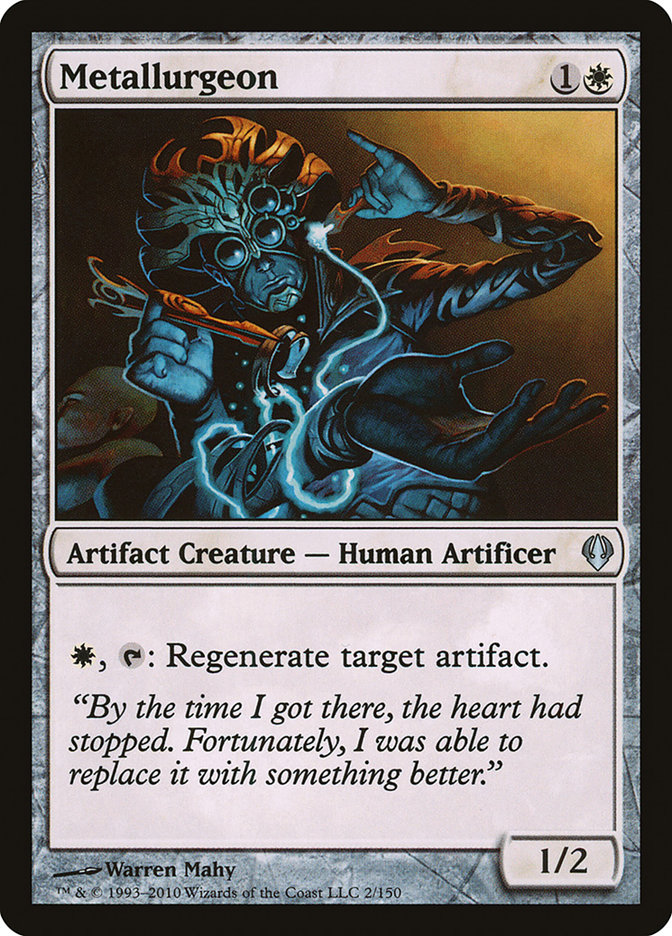Metalurgião Carta MTG
| Expansões | Lançada em 2 expansõesVer todas |
| Custo de mana | |
| Custo convertido de mana | 2 |
| Raridade | Incomum |
| Tipo | Criatura Artefato — Humano Artesão |
| Ataque | 1 |
| Defesa | 2 |
Texto da carta
{W}, {T}: Regenere o artefato alvo.
"Quando cheguei lá, o coração já havia parado. Felizmente, pude substituí-lo com algo melhor."
Texto da carta Metalurgião
{W}, {T}: Regenere o artefato alvo.
"Quando cheguei lá, o coração já havia parado. Felizmente, pude substituí-lo com algo melhor."
Onde comprar
Se você deseja comprar um cartão Metalurgião MTG de um conjunto específico como Shards of Alara and Archenemy, há diversas opções confiáveis a serem consideradas. Uma das principais fontes é a loja de jogos local, onde muitas vezes você pode encontrar boosters, cartas individuais e decks pré-construídos de conjuntos atuais e de alguns conjuntos anteriores. Eles geralmente oferecem o benefício adicional de uma comunidade onde você pode negociar com outros jogadores.
Para um inventário mais amplo, especialmente de conjuntos mais antigos, mercados on-line como TCGPlayer, Card Kingdom e Card Market oferecem seleções extensas e permitem que você pesquise cartas de conjuntos específicos. Grandes plataformas de comércio eletrônico, como eBay e Amazon, também têm listagens de vários vendedores, o que pode ser um bom lugar para procurar produtos lacrados e achados raros.
Além disso, o site oficial do Magic geralmente tem um localizador de lojas e listas de varejistas para encontrar a Wizards of the Produtos licenciados pela Costa. Lembre-se de verificar a autenticidade e a condição dos cartões ao comprar, especialmente de vendedores individuais em mercados maiores.
Abaixo está uma lista de alguns sites de lojas onde você pode comprar os Metalurgião e outras cartas MTG:
 COMPRAR
COMPRAR BurnMana é parceiro oficial da TCGPlayer
- eBay
- Card Kingdom
- Card Market
- Star City Games
- CoolStuffInc
- MTG Mint Card
- Hareruya
- Troll and Toad
- ABU Games
- Card Hoarder Magic Online
- MTGO Traders Magic Online
Veja produtos de MTG
Expansões
A carta Metalurgião Magic the Gathering foi lançada em 2 expansões diferentes entre 2008-10-03 e 2010-06-18. Ilustrado por Warren Mahy.
| # | Lançamento | Nome | Código | Símbolo | Número | Moldura | Layout | Borda | Artista |
|---|---|---|---|---|---|---|---|---|---|
| 1 | 2008-10-03 | Shards of Alara | ALA | 19 | 2003 | Normal | Preta | Warren Mahy | |
| 2 | 2010-06-18 | Archenemy | ARC | 2 | 2003 | Normal | Preta | Warren Mahy |
Legalidades
Magic the Gathering formats where Metalurgião has restrictions
| Formato | Legalidade |
|---|---|
| Commander | Válida |
| Legacy | Válida |
| Paupercommander | Restrita |
| Modern | Válida |
| Oathbreaker | Válida |
| Vintage | Válida |
| Duel | Válida |
| Predh | Válida |
| Penny | Válida |
Regras e informações
O guia de referência para regras de cartas de Magic: The Gathering Metalurgião fornece decisões oficiais, quaisquer erratas emitidas, bem como um registro de todas as modificações funcionais que ocorreram.
| Data | Texto |
|---|---|
| 2008-10-01 | The only difference between a colored artifact and a colorless artifact is, obviously, its color. Unlike most artifacts, a colored artifact requires colored mana to cast. Also unlike most artifacts, a colored artifact has a color in all zones. It will interact with cards that care about color. Other than that, a colored artifact behaves just like any other artifact. It will interact as normal with any card that cares about artifacts, such as Shatter or Arcbound Ravager. |

